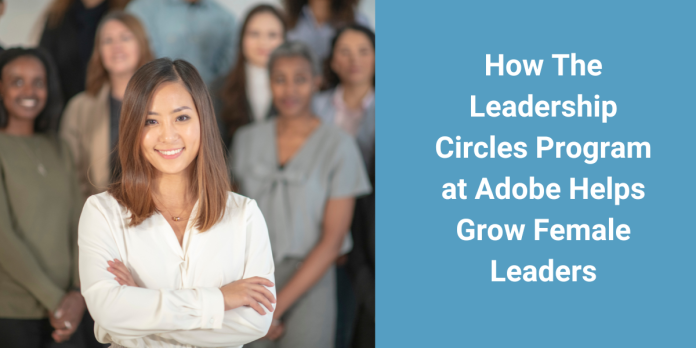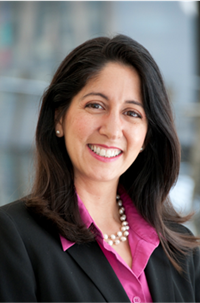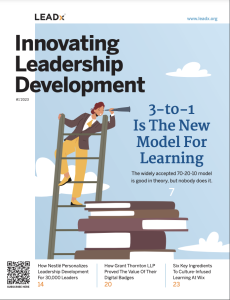
The Director of DE&I Talent Development at Adobe, Angela Arvizu Szymusiak, began working at Adobe right out of college. At that point in time, she was one of 300 employees, and their main product was PostScript.
Over her 20+ years at Adobe, Szymusiak has helped Adobe grow into one of the largest and most diversified software companies globally. Their mission is to change the world through digital experiences. As Adobe celebrates its 40th anniversary, they stand at over 28,000 employees.
 One of Szymusiak’s crowning accomplishments during her tenure has been to expand and produce the Leadership Circles™ program at Adobe, which is based on the book The Inner Edge: The 10 Practices of Personal Leadership, by Joelle K. Jay, Ph.D., and is delivered by and in partnership with the Leadership Research Institute (LRI). The program celebrates its 10th year at Adobe, and over 800 high-performing women at Adobe have graduated with an impressive 35% of participants having been promoted to Director-level and above.
One of Szymusiak’s crowning accomplishments during her tenure has been to expand and produce the Leadership Circles™ program at Adobe, which is based on the book The Inner Edge: The 10 Practices of Personal Leadership, by Joelle K. Jay, Ph.D., and is delivered by and in partnership with the Leadership Research Institute (LRI). The program celebrates its 10th year at Adobe, and over 800 high-performing women at Adobe have graduated with an impressive 35% of participants having been promoted to Director-level and above.
It all began in 2013 when Adobe noticed a need in the Sales Organization: To diversify their leadership pipeline.

This interview was edited for clarity and concision.
Adobe Launched the Leadership Circles Program to Invest in Talent and Diversify its Leadership Pipeline
Kevin Kruse: When did Adobe first launch the Leadership Circles program? Why at that moment in time?
Angela Szymusiak: We launched the Leadership Circles program at Adobe in 2013. Like many tech companies, we saw an opportunity to do a better job of ensuring that our leadership represented the diversity of the world around us. We wanted to invest in our talent and diversify our leadership pipeline.
At Adobe, we believe that people are our most important asset. When we hire very talented, ambitious individuals, they want to continue to grow. They want to make an impact. Through this program, we're investing in our female employees and telling them: “We're doubling down on your growth and development, we believe in you, and we're putting time and resources into supporting your growth.” We know from all the research that employee growth and development is one of the key drivers for people staying at an organization. If they feel that they are invested in, growing, and have growth opportunities, they’re less likely to leave.
We first launched Leadership Circles within the Sales organization. It was a success, so we repeated it for many years. After the fourth year, our Engineering and Product organizations approached us about expanding the program with them. We did, and a year after that, we expanded the program to all corporate functions. For the last five years, it has been a corporate-wide program. Adobe is a place that celebrates creativity, curiosity, and constant learning. I believe Leadership Circles is a great example of a long-lasting, impactful program that empowers women to bring their best selves to work and helps them unlock their full potential.
The Selection Process: 150 Executive-Nominated Leaders
Kruse: How do you select your participants for Leadership Circles?
Szymusiak: Our senior leaders identify their high-performing, high-potential women leaders. Typically, these nominees are just below the Director level. That's where we have more women, and we're trying to build them into Director-level and above. Historically we have had 120 participants, but this year we are expanding to 150 participants.
Program Design: 10 Monthly Topics, Executive Coaching, and Long-Term Pull-Through
Kruse: What’s the design of the program?
Szymusiak: The first month starts with a vision of what success looks like, personally and professionally. We break that vision into key priority areas and get into strategic actions that bring value to the organization. Each month after that, we focus on a different practice of personal leadership.
- What are your superpowers? What are your unique talents and strengths? How can you amplify them and bring them to the organization?
- What are your values? If your work aligns with your values, that supercharges your impact.
- Who can be on your personal board of directors to support your success?
- How can you maximize your time for greater impact?
Along with those monthly sessions, we break participants into groups of four to six people called Masterminds. Mastermind meetings allow participants to develop a small cohort of trust where they can peer coach, go deeper into the content, and support each other with business challenges. We also assign participants an executive coach. They meet with this executive coach throughout the program to go deeper into the content and to create business value for the organization.
Kruse: How often do participants meet with their executive coaches? And what do those meetings look like?
Szymusiak: Participants meet one on one with their executive coach six times throughout the year. They work with their coach to amplify the program's learnings and support their growth as strong leaders. They go deep into the content and discuss business challenges they’re facing. For example, if they have a new work project and need guidance on how to approach it strategically, they can discuss that with their executive coach: Who are the right people to engage? How do I creatively approach this problem? How do I maximize results?
Thoughtful Application Exercises Help Participants Overcome the Knowing-Doing Gap
Kruse: One area I’m incredibly passionate about is how to make learning stick. What are you doing to overcome the knowing-doing gap?
Szymusiak: Learning pull-through begins during their sessions. After we introduce the concept, we send participants to breakout sessions to interact and wrestle with new concepts. Each breakout session prompt helps participants put these concepts to practice:
- How will they use this concept?
- What will it look like?
- What questions do they have?
Any “homework” we assign helps participants put their learning into action. One of the best ways we do this is by encouraging participants to engage with their manager. Periodically, I update the people managers on what we've covered, what’s to come, and how they can continue supporting their employees who are participating in Leadership Circles. We also ask the participants to give monthly updates to their managers and share what they learned, how they can apply it, and how their manager can help:
- “I'd like to learn your best practices on how you do ____.”
- “Is there somebody you think who's good at this that you could introduce me to?”
- “Is there feedback you can give me as I apply a new concept?”
It’s about encouraging participants to engage their managers throughout this yearlong experience to help ground their learning and make it practical, relevant, and valuable in their day-to-day jobs.
Adobe Establishes An Ongoing Network of Learning for Women in Leadership
Kruse: Is there a capstone or graduation event?
Szymusiak: We have Celebration Days at the end, where we reflect on the journey over the last year:
- What did you achieve along the way?
- What were your big successes this year?
- How do you want to begin planning for next year?
- What do you want to achieve?
The idea is to give them a repeatable framework they can use in 2023, 2024, and beyond. It's not just one-and-done. It's building the skills, the muscles, to be able to lead their “self” and lead in the organization.
Then they graduate to our alum community, which stays connected. We have an internal channel where people share. I continue to post monthly about the latest personal leadership practice to help them reconnect to the concepts. When participants learn something during the program, it may not be 100% relevant to what they need at that moment in time. But, a year from now, when they're no longer in the program, that tip or concept could resonate.
The Results: 35% of Participants Have Progressed to Director Level and Above
Kruse: How do you measure success? What results have you seen from the program?
Szymusiak: Throughout the program, we conduct surveys. We do pre- and post-program surveys. We also do a midpoint pulse survey, and I continue to pulse leaders throughout the year around questions like:
- How is this program going?
- Do you see changes in your behavior and way of thinking?
- What's the impact on your growth?
- What’s the impact on the business?
We also measure the program’s success through Concrete Measurable Results, or CMRs. It's a framework to help participants talk about the impact of their work in a succinct and powerful way. A lot of times, we “work, work, work” and just assume someone's going to recognize it, and then the Job Fairy is going to come, and boom, you get promoted. The reality is it doesn't always happen that way. You have to be able to talk about your impact: Not your activity, but your impact on the business. Each participant submits one Concrete Measurable Result at the end of the program. This concept of CMR helps show participants’ immediate impact on the business in dollars, percentages, metrics, customer impact, et cetera.
The final way we measure success is through promotions. As of today, 35% of our alums are Directors and above. Of those, twenty-four are Senior Directors. Four are Vice Presidents at Adobe.
 5 Ways Adobe Dramatically Improved their Program over the last Decade
5 Ways Adobe Dramatically Improved their Program over the last Decade
Kruse: How has the program evolved over the last decade?
Szymusiak: The essence of the program has remained unchanged, but LRI and I are continuously seeking ways to improve. We want each change to have a transformational impact, not an incremental one. Here are five examples of transformative improvements:
First, we increased our engagement with the participants’ managers. Managers are busy, and we found that they weren’t always engaging with their employees about the program independently. So, my periodic updates remind them and give them some simple questions to ask, making it easy for them to check in.
Second, we added an element where the manager meets with their participant’s coach at the beginning of the program. The coach hears directly from their participant’s manager about:
- What are the key priorities for this individual?
- What do they do well?
- What are their opportunities for improvement?
- What are some of the challenges that their team may be facing?
This meeting helps the coach build context for their executive coaching sessions.
Third, we added a meeting at the end of the program between the participant, their coach, and their manager. In this meeting, the participant covers their key learnings, how they want to continue growing, and how their manager can continue to support them.
A fourth component that we added is what we call Executive Champions. These are vice presidents across the organization who commit to participating in the yearlong program alongside the participants. The Champions discuss how they apply these practices from the program to create business impact.
Lastly, we want to make it easy for alums to find growth opportunities at Adobe. With over 28,000 employees, there are many opportunities. But it can be challenging to know where those opportunities are. So, I bring in our executive recruiting team each year to talk to my alums and help make it easier for them to find their next opportunity.
A Lesson for Leadership Development Professionals: Make Changes on the Transformational Level
One crucial lesson from this interview that you can apply to any training program is this: Seek to make transformational changes, not incremental ones. Szymusiak and LRI built impressive results, like their stat of over 35% of alumni at the Director-level and above, by thinking big. Instead of small tweaks or minor improvements, she made adjustments that helped learners overcome the knowing-doing gap and change their behavior long-term.



 5 Ways Adobe Dramatically Improved their Program over the last Decade
5 Ways Adobe Dramatically Improved their Program over the last Decade



